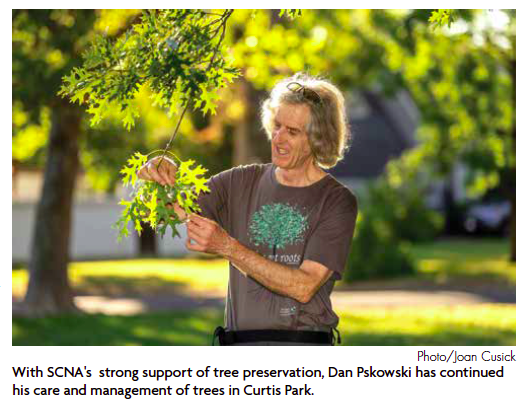When I first moved from Fort Collins, Colo., to accept the position of Sacramento city arborist, my goal was a less physically demanding position for my back. I never dreamed retiring more than 29 years later from this career.

My back never got strong enough to endure the physically demanding work of pruning and removing trees. But what made me stay was Sacramento’s incredible collection of trees and its people.
After my first summer here, I quickly realized why trees were so important in Sacramento. Citizens strongly supported tree preservation, especially in the Curtis Park neighborhood. As city arborist, I interacted with various neighborhood associations.
SCNA always stood out because it backed up its commitment to trees with action. In 1994, SCNA contracted with a private arborist to survey all trees in William Curtis Park, the first step to managing trees. Four years later, the city’s annual Arbor Day celebration was held in the park, which was the catalyst for other tree-planting events in the neighborhood.
In November 1996, neighbors voted to support Measure O, a landscape and lighting assessment for tree care. Additional funding was required for the care and maintenance of Sacramento’s urban forest. The 1994 Urban Forest Management Plan indicated that funding, starting in the 1960s, did not keep up with Sacramento’s growing tree population.
Dutch elm disease required removing several of the park’s English elms in 2007. SCNA funded the treatment of these elms with a fungicide injected every three years.
As the sole city arborist until 2006, I appreciated the support throughout the city. Trying to address the needs of more than 100,000 street and park trees was overwhelming. After repeated requests, two additional arborists were hired. I had envisioned opportunities to deliver better service to the public and manage the trees in a more thoughtful, pragmatic way instead of just reacting to the immediate concern.
When Ray Kerridge was appointed city manager, my career took a turn for the worse. The city manager’s direction for development to city staff was sites needed to be “shovel ready.” Trees were no longer incorporated into the project. It became “remove and replace,” not just for on-site trees but the public street trees.
I did not accept Urban Forestry’s new direction of crafting ways to remove trees, which included misleading the public. I voiced my objections and soon no longer participated in the review and comment of new development projects. I had become an obstacle and was being pushed out the door. I stayed on because Sacramento residents were pleased with my work in the care and protection of trees.
In 2009, I was moved out of Urban Forestry and assigned to the concrete maintenance section to perform root inspections for sidewalks and other concrete repairs. This was my punishment for speaking the truth instead of what management wanted me to say.
In response to the “remove and replace” policy, neighborhood tree activists formed the nonprofit Trees for Sacramento to protect and enhance Sacramento’s urban forest. I volunteered my time assisting this group. It was a challenge being a city employee and testifying at tree appeals contradicting Urban Forestry responses to various tree issues.
After one of these meetings in 2012, longtime SCNA board member Andrea Rosen invited me to join the board. I did and only regret not doing it in 2004, when I moved into the neighborhood. My management now had a harder time bullying me because I was part of the neighborhood association.
In 2013, I was chosen as the SCNA representative for the Stakeholders Advisory Committee to work on the revision of Sacramento’s tree ordinance. Urban Forestry officials tried to get me removed because my knowledge and experience threatened their strategy to weaken the tree ordinance. Former SCNA Board President Eric Johnson stood his ground and told the city I would not be replaced.
Another example of the Curtis Park neighborhood stepping up to protect the trees is when residents on 24th Street physically blocked a contractor from removing three large 40- to 60-foot tall plane trees for the Crocker Village project. A follow-up investigation indicated that these three trees were not on the development site.
Sadly, there has been a significant loss of canopy coverage and space to plant trees in the central city and some neighborhoods. However, the Curtis Park neighborhood has remained a beacon of hope.
In my opinion, Sacramento is no longer the “City of Trees,” but Curtis Park remains the “Neighborhood of Trees.”
I thank all of you and tree activists throughout the city who continue inspiring me to never give up.